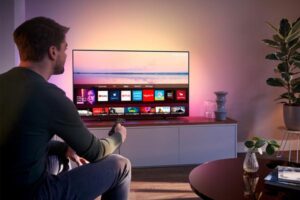
Properly maintaining a smart tv is critical for guaranteeing its longevity and best performance. You may dramatically extend the life of your smart TV by following a few dos and don’ts. In this article, we will look at the best practices for extending the life of your smart TV, as well as vital suggestions on what to do and what to avoid. Implementing these suggestions will help you get the most out of your smart TV.
From proper posture and frequent cleaning to avoiding power surges and minimising screen burn-in, Systems Insights provides you some key tips that will also help keep its quality for years to come.
Things you should do to maximize your smart TV’s lifespan-
- Proper Placement: Keep your LED television in a well-ventilated environment free of direct sunlight and sources of heat.
- Dusting: Clean your TV’s screen and vents on a regular basis to avoid the accumulation of dust, which can impair efficiency and result in overheating.
- Power Surge Protection: To protect your TV from power fluctuations and electrical surges, use a surge protector or uninterruptible power supply (UPS).
- Stable Power Supply: Avoid repeated power on and off cycles, which can cause internal parts to strain. Make use of a reliable power supply.
- Screen Saver: To avoid screen burn-in, use a screen saver or switch off the TV when not in use for an extended length of time.
- Energy-Saving Mode: Turn on your TV’s energy-saving mode to reduce power usage and heat generation.
- Avoid Extreme Temperatures: Extreme temperatures, both hot and cold, might harm the internal parts in your television.
- Proper Handling: Handle your TV with care while moving or transferring it to avoid physical damage to the screen or internal components.
- Avoid Excessive Pressure: Pressing too hard on the screen might result in irreversible damage.
- Update Firmware: Update the firmware on your television on a regular basis to guarantee maximum performance and access to the most recent features.
- Proper Ventilation: Make sure that the vents on the rear of the television are not blocked, enabling sufficient circulation and eliminating overheating.
- Avoid Liquids: Ensure liquids are kept away from your television to avoid spills that might cause irreversible harm.
- Avoid Magnetic Fields: Strong magnetic fields can interfere with the display and internal components of your television, so keep it away from them.
- Use the Remote: Reduce manual button usage on the TV to save wear and tear on the physical controls.
- Avoid Sharp Impact: Avoid striking or bumping your television, since this might cause damage to the screen or its internal parts.
- Optimal Brightness: Customise the brightness and contrast levels to a range which is comfortable for viewing while decreasing strain on the LED backlight.
- Regular Updates: Update the TV’s software and applications regularly to ensure compatibility and performance improvements.
- Proper Cable Management: Cables should be carefully organised and routed to avoid being bent, pinched, or broken.
- Avoid Static Images: To avoid picture retention, avoid displaying static images or logos for lengthy periods of time.
- Professional Maintenance: If you detect any severe faults or abnormalities, consider calling a professional expert for repair and maintenance.
While these suggestions can help extend the life of your LED TV, keep in mind that electrical equipment have a finite lifespan, and some wear and tear is unavoidable.
Things to avoid to maximize your smart tv’s lifespan-
There are several common causes that can lead to LED TV failure. Here are some of them:
- Power Surges: Electrical power spikes or oscillations can harm the internal components of an LED TV, notably the power supply or circuit boards.
- Overheating: Poor ventilation, clogged vents, or positioning the TV in a small place can cause overheating, causing the TV to malfunction or possibly cease altogether.
- Physical Damage: Accidental collisions, dropping the TV, or mistreatment can result in cracked displays, damaged internal components, or loose connections, all of which can lead to TV failure.
- Ageing Components: Certain components inside the TV, such as capacitors or backlight units, might deteriorate or wear out over time, resulting in faults or a full failure.
- Liquid Damage: Spilling liquids or exposing the TV to moisture can cause short circuits or corrosion, resulting in irreparable damage to the internal circuitry.
- Power Supply Issues: Faulty power cables, connections, or power supply units might create intermittent power issues or prevent the television from turning on at all.
- Firmware or Software Errors: System failures or anomalous behaviour might result from flaws, defects, or compatibility issues in the TV’s firmware or software.
- Defective Backlight: The backlight device, which is in charge of lighting the screen, might malfunction over time, resulting in a dark or flickering display.
- Image Retention or Burn-In: Long-term display of static pictures or logos can result in image retention or burn-in, resulting in persistent discolouration or ghosting on the screen.
- Electrical or Internal Component Failures: Internal parts such as the mainboard, CPU, or memory modules might fail owing to manufacturing flaws or wear and use.
It’s important to note that while these causes are common, not all smart TVs will experience them, and regular maintenance, proper handling, and usage can help minimize the risk of failure.
